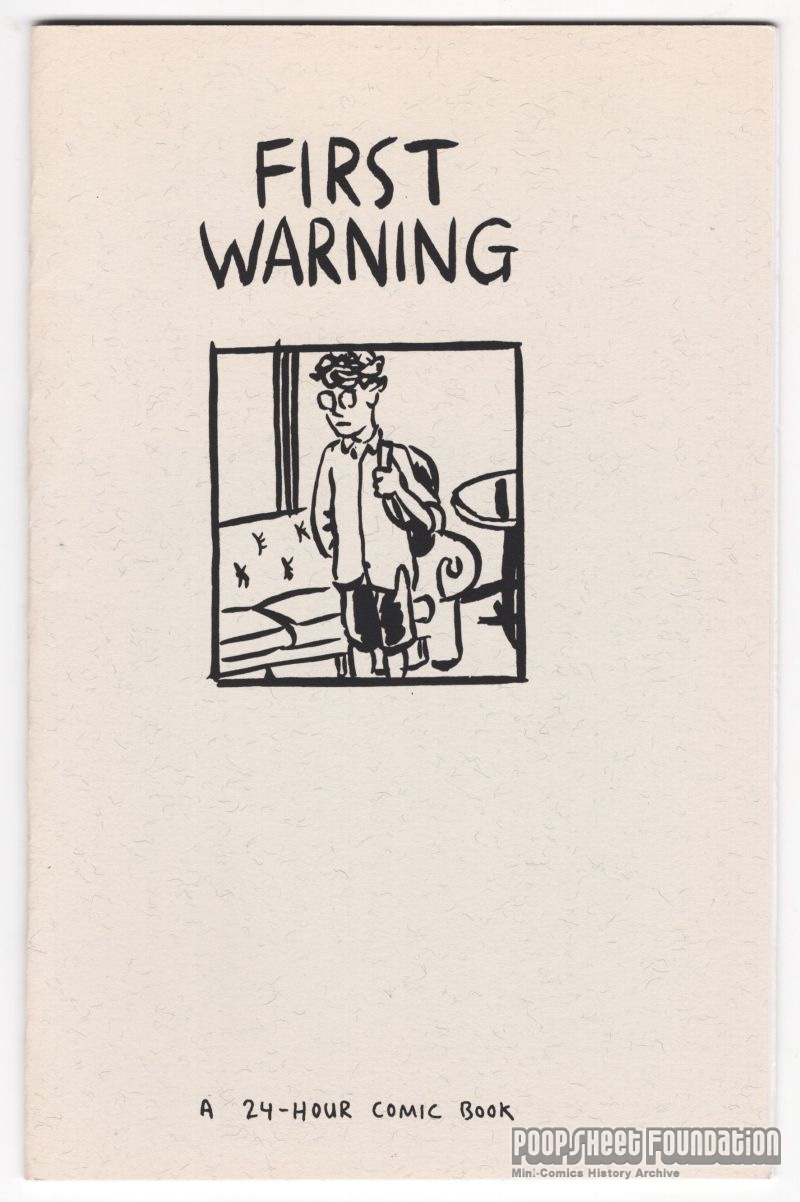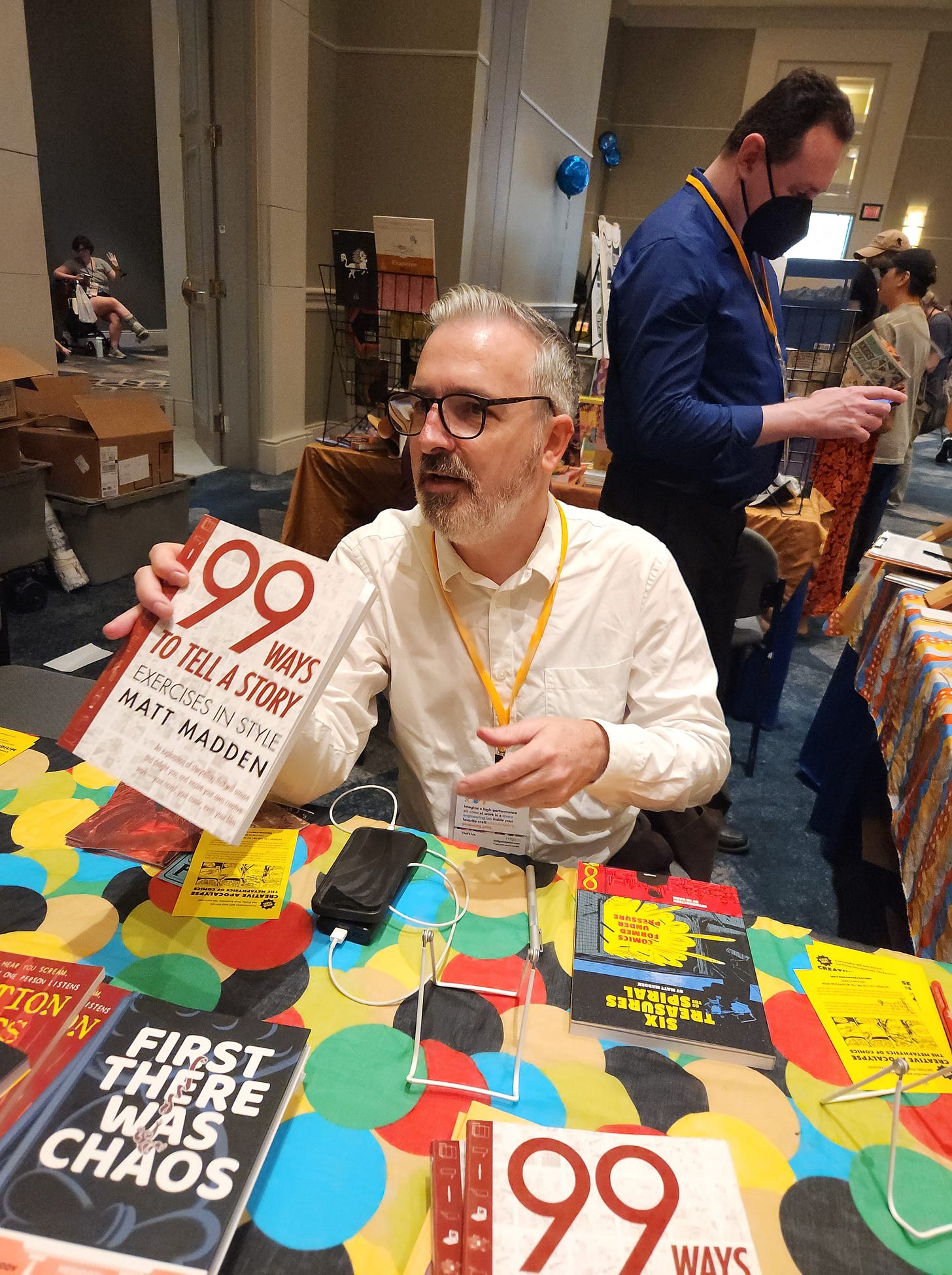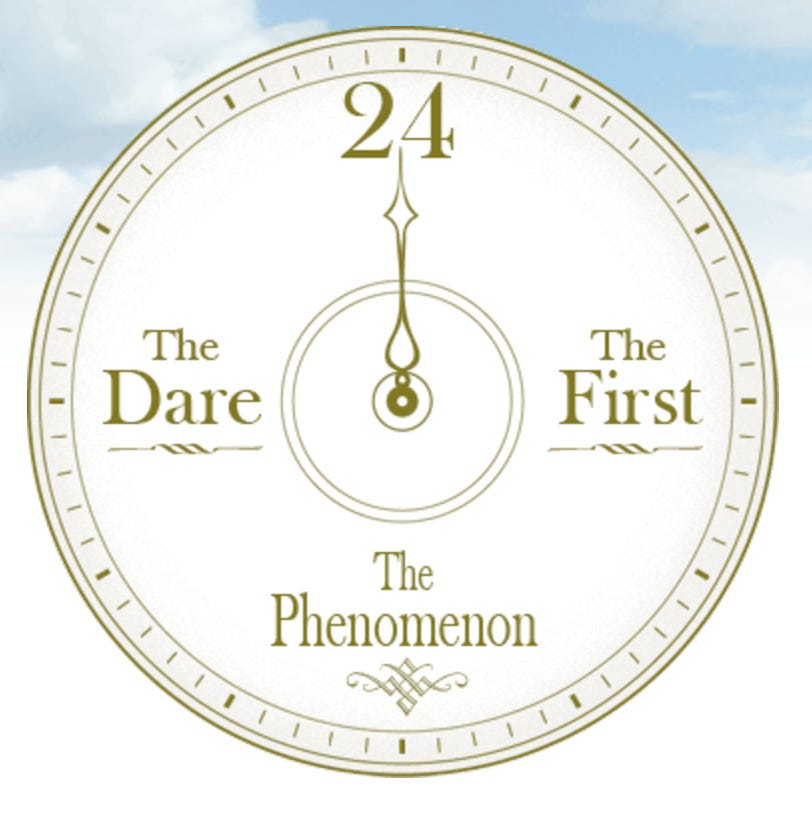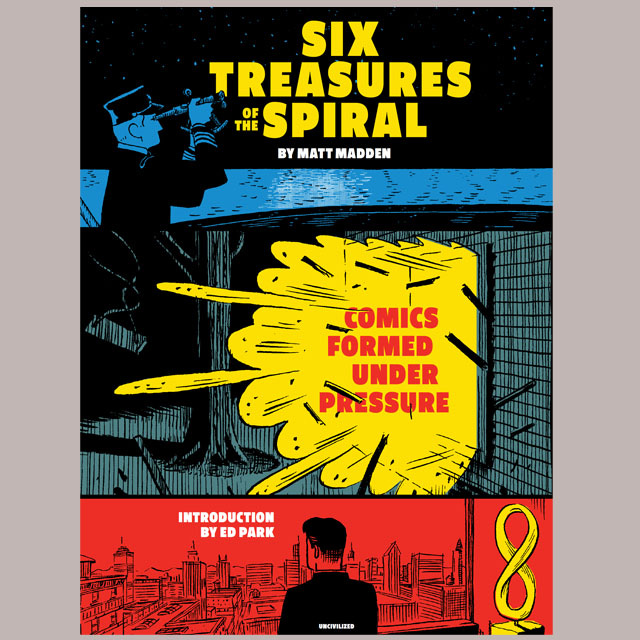A small news item to start: Comics scholar and booster Mike Rhode interviewed me for his blog on the occasion of my book release and my annual visit to SPX, the Small Press Expo.
I talked a lot about constraints, as usual:
What do you do when you're in a rut or have writer's block?
I don’t really get writer’s block, that’s one of the appeals to me of constraints: if I’m not sure what I want to draw or write about, I can set myself an arbitrary constraint (say: make a one-page comic using only triangles and circles) and that puts me in problem-solving mode rather than worrying about whether I have anything to say.
My First Encounter with the 24 Hour Comic
I’m going to take a little detour into my early years as a cartoonist in this post so that you can see how rules and constraints have been appealing to me from the very beginning—and also how they have always been a prominent aspect of comics and zine culture, this time in the form of Scott McCloud’s 24 Hour Comic challenge, which asks you to write, pencil, and ink a 24-page comic in 24 hours.
If you’re not a cartoonist, I can promise you that, yes, this is a very difficult challenge, yet not an insurmountable one, as several generations of cartoonists all over the world can attest!

First Warning
At 10AM on May 5, 1996, I sat down on the floor of my apartment in Austin, Texas along with three cartoonist friends: Tom Hart, Warren Craghead, and Josué Menjívar. Our mission: to each conceive, write, pencil, and ink a 24-page comic in 24 hours! At that date, this was still a pretty new idea, a creative challenge the cartoonist Scott McCloud had invented a few years earlier (see my note on Scott’s influence below).
Tom was an early adopter and had already gone through this ritual twice, so he acted as our MC and timekeeper.
We drank coffee and started doodling and writing down ideas for stories. I remember Tom had a lot of scraps of paper with him full of ideas and bits of dialogue. We spent a lot of the time talking about our creative process, sharing how we came up with and developed ideas (I wish I’d take notes or at least some photos).
We took regular breaks and we went out for pizza at some point. Otherwise we all four sat there for 24 hours straight, scribbling, chatting, listening to music, and slowly penciling and inking comics. Bit by bit, I developed a narrative sketch based on some drawings in my sketchbooks of people in local cafés.
By 10AM on Sunday morning, after an early morning coffee run, Tom had already been done for a few hours and I believe Warren completed his comic around the finish line. Josué and I were the stragglers. I had planned out and penciled a story and I had inked about 2/3 of it.
I don’t remember what Josué did but I stretched the rules and went to a café a few days later and gave myself four hours to finish up: to completely write and draw a comic in 28 hours is still a feat, I argued to myself!
I had an ulterior motive for taking on this ambitious challenge: I was getting ready to draw my first extended comics narrative and, having only drawn 2-3 page comics up to that point, for the most part, I needed to psyche myself up to draw a longer work.
I was also still learning how to ink with a brush and I had a feeling that only an extended session of inking-on-deadline would make me overcome my tentativeness with the brush, which was manifesting in a wobbly, uncertain line. I guess I saw this project as a sort of shortcut of my 10,000 hours to get to Carnegie Hall.
The results are pretty painful to look at now and even at the time I winced at their sloppiness yet at the same time I was giddy to have drawn so much in so short a time.
I could see a bit of fluidity and confidence developing in my brushwork, at last. And I really liked how the panel borders looked when inked with a brush (kept straight by running the metal ferrule along the edge of a ruler).
By the time I got to inking what would be my first published book, Black Candy, a few years later, I felt like I’d developed into a passable brush inker (even if I cringe to look at much of that book as well, at this point). I don’t think I would have reached that level without doing the 24 Hour Comic.
24 Hour Comic as Proto-Oubapo
It’s interesting to note that this project predates my discovery of Oulipo and the world of using constraints to make art. I don’t believe Scott McCloud had French experimental novelists in mind either when he came up with this challenge to nudge a blocked friend into creating new work.
But the principle is the same: by giving yourself an arbitrary and somewhat impossible-seeming constraint, countless of you have found that you can, in fact, do a fun and sometimes excellent comic (or play, or song—again, see below) in just one day.
For me, the 24 Hour Comic tickled something in me that I wouldn’t fully formulate until I started adapting Raymond Queneau’s Exercises in Style into comics a few years later (and which this Substack is devoted to exploring—hi there if you’re a new reader!)1.
I was clearly honing in on an approach to making art that clicked with me in this period: in another precursor to my discovery of constraints, when I started planning Black Candy, I decided that I would ink everything with a brush (except for the lettering—I’m no Seth!) instead of using the nibs and technical pens I had been favoring to that point. I also committed to using no voiceover narration in order to force myself to work on visual storytelling. I thought of these as “parameters” at the time and maybe that’s appropriate as they are relatively “soft” or easy rules to follow.
Preaching the 24 Hour Gospel
I’ve been an evangelist for 24 hour comics ever since that first session, especially to young artists who feel like they “aren’t ready” or “can’t do it” or “can’t write a long comic”—I thought all those things too, before I dove in (thanks to Tom’s nudging).
Not incidentally, it’s a great social and community-building activity, which is important for an art form like comics where most of us spend our days alone at our drawing tables or tablets.
It’s an adaptable form, too: when Jessica and I were teaching at the School of Visual Arts, one of our end-of-year Storytelling classes would be a “3 Hour Comic” challenge: the class session being three hours long, we had student write and draw a three page comic with no advance planning or warning.
The influence of Scott’s Invention
I don’t think Scott McCloud gets enough credit for the number of movements his invention spawned in the years since he introduced the 24 Hour Comic in 1990. By his own reckoning, the 24 Hour Plays was the first project to be at least indirectly inspired by the 24 Hour Comic.
I also see the influence in more drawn out time-based challenges like Inktober and NaNoWriMo or any number of musical challenges along these lines, from NPR’s short-lived Project Song (check out Stephin Merritt’s contribution in particular) to WXPN’s 24 Hour Song Challenge here in Philly.
So let’s all thank Scott for giving us such an enduring idea!
Give It a Try!
The rules for making a 24 Hour Comic are straightforward:
Set aside a continuous 24-hour period and find some willing fellow travelers. Saturday 10AM to Sunday 10AM is a good time window to use.
Show up with paper and drawing materials, any kind of random inspirational material, photo reference, etc. But DO NOT show up with an idea already in mind!
One way to be sure you don’t “cheat” is to have someone propose an additional constraint at the outset (for example: “the comic must be wordless” or “there must be a love triangle”). More on this rule in the next post!
Get to work! Remember to take breaks, stay hydrated, take a nap or two.
When you’re done, print a minicomic or post it online, you need to share your triumph!
You can also read Scott’s own instructions, along with some pointers, here.
I’ll be back soon with a follow-up post about a more recent attempt at a 24 Hour Comic, one which resulted in one of my comics I’m most proud of: you never know where these constraints and challenges are going to take you…
Meanwhile, remember that my collection of constrained comics, Six Treasures of the Spiral: Comics Formed Under Pressure, is now officially in stores!!
Publishers Weekly gave it a starred review, calling it “an instant classic.” (Read the whole review here.)
Thanks for reading. If you’re not already using the Substack site or app, I recommend it:
I hope you’ll share this post if you enjoyed it and feel free to leave a comment. See you soon.










I think my days of 24 hour marathons are behind me, but it's a great idea.
Great work Matt!! The work with colleagues/small groups is a great way to connect & accomplish!!👍❤️